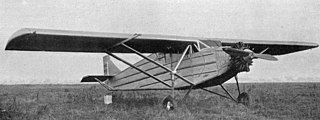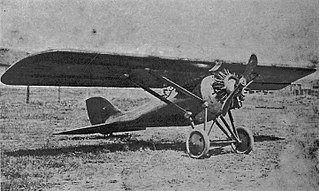Related Research Articles

The Lublin R-X was a Polish single-engined, two seat liaison aircraft, built in 1929 in the Plage i Laśkiewicz factory in Lublin. Seven were completed, two of them prototypes. Four served with Polish air regiments and another made several notable long flights and tours.
The Koolhoven F.K.42 was a parasol-wing, two-seat training monoplane manufactured by Koolhoven in the Netherlands. Only one was built.

The Heinkel HD 20 was a twin engine, three seat German biplane built in 1926 for civil survey work.
The Potez 51 was a 1930s French intermediate trainer, intended to replace the ageing Potez 25 which had sold worldwide. It did not go into production.
The Weymann W-100, Weymann CTW-100 or Weymann W-100 RBL was a French three seat observation aircraft with a position for the observer within its partially glazed fuselage. Only one was built.

The Morane-Saulnier MS.350 was a French aerobatic trainer flown in 1936. Only one was built but it had a long career, flying post-war until the 1960s.
The Caudron C.860 was a single engine, single seat monoplane ordered by the French government as a long distance communications aircraft. First flown in 1938, it was also expected to set speed and altitude records but the outbreak of World War II ended developments.
The Curtiss-Reid Courier was designed in Canada in 1931 as a specialist, non-passenger carrying, mailplane capable of maintaining services in Canada's hard winters. The 1930s depression led to the end of government subsidised airmail contracts and only one prototype flew. It was lost in 1933 during preparations for a private, long distance flight.
The Morane-Saulnier MS.300 and MS.301 were French parasol wing introductory trainer aircraft, first flown in 1930. They differed only in engine type. Neither reached production but were developed into two similar trainers, the MS.230 and MS.315, which were made in large numbers.
The Couzinet 100 was a three-engined, three-seat touring aircraft designed and built in France in 1930. Two variants, the Couzinet 101 and Couzinet 103, were very similar apart from their engines; no variant reached production.

The Albatros L 83 Adler was a small, fast transport aircraft for passengers, mail or other cargo, flown in Germany in 1931. Two were built.
The S.A.B.C.A. S.XII or S.A.B.C.A S.12 was a four-passenger light transport aircraft with three engines and a high wing, built in Belgium in the early 1930s.

The Charmier-Dupuy 10 was a French parasol-winged single seat light aircraft designed for low-cost flying. The sole example was first flown in 1924. Over a long career, it was fitted with three different engines and remained on the French register until after World War II.

The Aerial Engineering Corporation Standard 6W-3 was a commercial transport modification of the US Standard J-1 biplane military trainer aircraft, with new wings, engine and accommodation for four passengers. First flown in 1925, it was built in small numbers.

The Raab-Katzenstein KL.1 Schwalbe (Swallow) was a German two-seat biplane produced in the 1920s. About fifty were built and the type became well known as an aerobatic aircraft, performing at many displays in the hands of pilots like Gerhard Fieseler.

The Aviaméta 92 was a French, all-metal, five seat monoplane built in the late 1920s. Three different engines were fitted, and one example flew the first non-stop Paris-Algiers flight in preparation for an abandoned trans-Atlantic attempt.
The Morane-Saulnier MS.152 was a French multi-purpose aircraft built in 1928. It did not go into production.

The low-powered Samolot Sp.I, designed in Poland in the mid-1920s, was intended to explore the characteristics of a proposed single seat fighter. The project did not receive government support and only one Sp.1 was built.

The Huff-Daland HD.8A was a small civil transport biplane carrying two passengers built in the U.S. in 1922. The otherwise identical HD-9A offered an alternative engine.
The Stampe et Vertongen ST.26 was a 1930s Belgian military blind- and night-flying trainer aircraft.